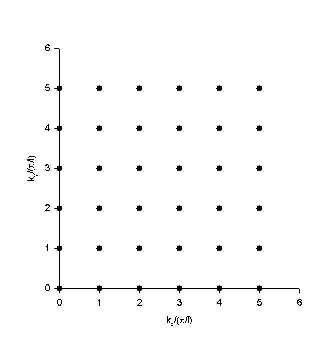Other problems with identical particles
A particle of mass m is in a cubical well if side L, corresponding to the
potential energy function
U(r) = 0 if |x|, |y| and |z| < L/2, U(r) = ∞ otherwise.
(a) What is its ground-state energy?
(b) What is the energy of the first excited state? Is this energy
level degenerate or non-degenerate? Explain!
(c) Suppose 20 identical, non-interacting particles of mass m and spin
½
are in this well. What is the ground state energy of this system? Is
this ground state degenerate or non-degenerate? Explain!
Problem:
Consider a "box" that is a two dimensional square well with sides of length L
x L. Inside the well the potential is U = 0, outside the well the
potential is infinite.
(a) Let the box contain one particle of mass M. Determine (or
write down) the general set of wave functions Φ(x,y),
find the allowed energies for these states and identify the eigenvalues kx
and ky for the particle.
(b) Write down the three lowest energy eigenvalues and note the degeneracies, if any.
(c) Make a plot, as a function of the eigenvalues kx and ky, showing the allowed states. On this plot, consider a
circle of radius k = (kx2 + ky2)½, with k
large. What is the area of this circle? Approximately how many states are
contained in this circle?
(d) Now suppose that the same box contains N identical,
non-interacting Fermi particles, each with mass M and spin ½. We have N >> 1. Find the energy of the highest occupied state, if the system
is in its ground state.
(e) For the N particle system in part d, calculate its total
energy
Solution:
- Concepts:
The two-dimensional, infinite
square well, the Pauli exclusion principle.
- Reasoning:
We are asked to find the
eigenfunctions and eigenvalues of the two-dimensional, infinite square well.
When we consider a system of N non-interacting fermions in that well, we must
take into account that each state can only be occupied by one spin up and one spin
down particle.
-
Details of the calculation:
(a) The eigenfunctions and
eigenvalues of the 2D infinite square well are
Φnm(x,y)
= (2/L)sin(kxx)sin(kyy), with kx =
πn/L,
ky = πm/L, n, m = 1, 2, ... .
The associated eigenvalues are
Enm = (n2 + m2)π2ħ2/(2ML2)
= (kx2 + ky2)ħ2/(2M).
(b) The three lowest energy
eigenvalues are
E11 = π2ħ2/(ML2),
E12 = E21 = 5π2ħ2/(2ML2),
E22 = 4π2ħ2/(ML2),
E13 = E31 = 5π2ħ2/(ML2).
The eigenvalue 5π2ħ2/(2ML2) is degenerate.
(c) kx
= πn/L,
ky = πm/L,
∆kx = ∆ky
= π/L.

The area of a circle in 2D k-space is A = πk2.
The number of states in the circle is Nstates = (A/4)/(π/L)2
= k2L2/(4π).
Only
positive values of kx and ky are allowed.
The
density of states in k-space is n(k) = dN/dk = kL2/(2π).
(d) Each state can be occupied by two particles, one with
spin up and one with spin down.
If the system is in its ground state all the lowest energy levels are filled.
The
energy of the highest occupied state is Emax = ħ2kmax2/(2M),
where Nparticles = (kmax2L2/(2π)
or kmax2 = 2πNparticles/L2.
(e) The number of states between k and k + dk that can be occupied is 2n(k)dk
= (kL2/π)dk.
The total energy of the system is
Et
= ∫0kmax(ħ2k'2/(2M))2n(k')dk'
= ∫0kmax(ħ2k'2/(2M))(k'L2/π))dk'
= (ħ2L2/(2Mπ))
∫0kmax k'3dk'
= (ħ2kmax4L2/(8Mπ))
.
Et = ħ2πN2particles/(2ML2)).
Problem:
Consider an ideal 3D Fermi gas comprising N non-interacting fermions, each
of mass M, in a container of volume V at T = 0
(a) Find the Fermi energy.
(b) Find ρ(E)dE the number of quantum states whose energy lies in the range
E to E + dE.
(c) Find the average energy per fermion at absolute zero by making a direct
calculation of U(0)/N, where U(0) is energy at T = 0 for N fermions. Express
this in terms of the Fermi energy, EF.
Solution:
- Concepts:
The Pauli exclusion principle, the Fermi energy
- Reasoning:
The Fermi energy is the energy difference between the highest and lowest
occupied single-particle states in a quantum system of non-interacting fermions
at T = 0.
- Details of the calculation:
(a) The eigenfunctions and eigenvalues of the 3D infinite cubic well are
Φnmp(x,y,z) = (2/L)3/2sin(kxx)sin(kyy)sin(kzz),
with kx = πn/L, ky = πm/L, kz = πp/L, n, m,
p = 1, 2, ... .
The associated eigenvalues are
Enmp = (n2 + m2 + p2)π2ħ2/(2ML2)
= (kx2 + ky2 + kz2)ħ2/(2M)
The spacing between successive allowed values of ki is ∆kx
= ∆ky = ∆kz = π/L. Only positive values of kx,
ky, and kz are allowed.
If k is large, then the number of states with wave vectors whose magnitudes is
less or equal to k is N = (1/8)(4π/3)k3/(π/L)3.
Each state can be occupied by two particles, one with spin up and one with spin
down.
The energy of the highest occupied state is EF = ħ2kF2/(2M),
with kF2 = (3Nπ2/V)(2/3).
EF = ħ2(3Nπ2/V)(2/3)/(2M) = ħ2(3nπ2)(2/3)/(2M),
where n is the number of particles per unit volume.
(b) The number of states with wave vectors whose magnitudes lie between k and k
+ dk is dN = (1/8)*2*4πk2dk/(π/L)3 = L3k2dk/π2.
dN/dk = L3k2/π2.
The density of states is ρ(E) = dN/dE = (dN/dk)(dk/dE).
With E = ħ2k2/(2M) we have ρ(E) = dN/dE = L3Mk/(πħ2)
= 2½M3/2VE½/(π2ħ3).
(c) <E> = (1/N)∫0EFρ(E) E dE = 2½M3/2/(nπ2ħ3)
∫0EF E3/2 dE = (2M)3/2/(nπ2ħ3)EF5/2/5.
<E> = [(2M)3/2/(nπ2ħ3)/5]EF*EF3/2.
EF3/2 = ħ3(3nπ2)/(2M)3/2.
<E> = (3/5) EF.
